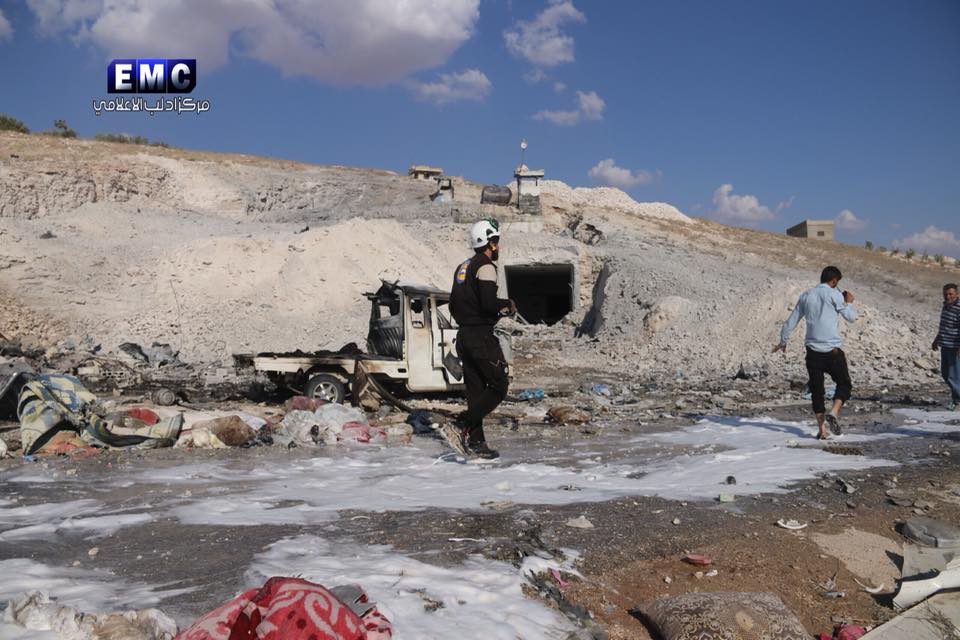Anatomy of a Sarin Bomb Explosion (Part I)
Part I: The Bomb, its contents, and their likely fate
The recent chemical attack in Khan Shaykhun in Syria is alleged by witnesses to have been delivered by an air-dropped bomb. The purpose of this article is to systematically break down a Sarin bomb into its components and analyse what happens to them. This first part addresses the contents of the bomb and how these components interact with the environment.
What’s in an air-dropped Sarin bomb? A Sarin bomb will contain more than just Sarin.
Sarin. The nerve agent Sarin will be in liquid form. However, no chemical reaction makes pure Sarin and no weapon system known to date contained just pure Sarin. Other things are likely to be present in some percentage. They are listed below.
Unreacted Components: It is highly unlikely that any Sarin binary mixing done before loading will be absolutely 100% effective. Bits of unreacted binary components that weren’t mixed properly, i.e. methylphosphonyl difluoride (DF) and isopropyl alcohol
Hydrogen fluoride (HF) : This results from the DF + isopropyl alcohol reaction. Also results from DF reacting with water.
Byproducts: chemicals that are formed by improper DF + alcohol reactions, or are left over in the DF as impurities from earlier stages of production.
Degradation products : Sarin, unless made properly, degrades quickly. And Sarin degrades in the presence of moisture. Degradation products are chemicals that result from degradation of the Sarin, such as isopropyl methylphosphonic acid, which in turn degrades to methylphosphonic acid.
Additives: Anything additional added, such as acid scavengers and anti-corrosion inhibitors, e.g. hexamine, tributylamine, etc. Also, as some additives are designed to react with the residual HF, the presence of these compounds, e.g. salts, may be present.
Fuze and Bursting charge: Explosive material to make the bomb burst open and create an aerosol. This would include the whole firing chain, with fuzing and several different explosive materials, as well as wiring.
Case material: This is the body of the bomb, including coatings and linings.
Design and Intent of the weapon

US “Weteye” Sarin Bomb
Non-persistent nerve agents, such as Sarin are used for immediate production of casualties, as their ability to produce contamination is time-limited. As such, Sarin weapons generally function on the principle of producing as much aerosol (a finely divided mist of droplets) as possible. Persistent nerve agents, such as VX, are designed to contaminate terrain and equipment, and cause immediate casualties primarily by skin contact. Therefore, they are often designed to cause dispersal of larger droplets.
How big an explosive charge?
The necessary “charge to agent” ratio is needed to ensure proper dissemination of the chemical agent contents. A bursting charge that is too small means that too little aerosol is created and you end up with a large pool of liquid or large splashes of Sarin – extremely deadly in the immediate vicinity, but not good for causing casualties over a wide area. If the bomb uses too much explosive, much or all of the Sarin is destroyed. Sarin decomposes at higher temperatures. At its boiling point, around 150 deg C, it decomposes rapidly. A large amount of high explosives would easily heat much of the Sarin in a bomb to 150 deg C.
The thickness and structural integrity of the case of the bomb is a key factor in the size of the burster charge, and one of the reasons why air-dropped bombs have a higher ratio of chemical agent to explosive than artillery shells, which, comparatively, have a thicker case. Data on charge to agent ratios for air-dropped bombs is rare, but some information from the old US chemical arsenal has now seeped into the public domain. These charge to agent ratios were fine tuned with extensive field testing at proving grounds and resulted in optimum formation of aerosol. For example, the MC-1 Sarin bomb contained 100kg of Sarin and had a burster charge weighing 6.8 kg, although not all of the 6.8 kg will be explosive weight, i.e. some of that weight will be wire and casing. The US Mk94 bomb held 49kg of Sarin and had a 7.3 kg burster. The Weteye bomb appears to have contained 159 kg of Sarin and had a large bursting charge, around 27 kg, leading one to deduce that it had a much thicker case. I can find no comparable statistics for USSR-produced systems.
Air-burst versus ground burst
Ever since the development of chemical bombs and artillery shells early in the 20th century, the general consensus among chemical weapons experts is that non-persistent agents are detonated at or near ground level, whereas persistent agents, whose primary purpose is contamination of terrain and equipment, are detonated as air bursts. Non-persistent agents are designed with production of casualties in mind and keeping the aerosol at or near ground level helps to maintain a higher concentration of the chemical agent than detonating in the air. The latter serves to dilute the concentration a little or a lot, depending on local conditions. With persistent agents, the idea is to have a wider radius of dispersal of droplets to cause contamination of terrain and equipment. The air-dropped bombs for delivering Sarin developed in the US in the Cold War were all impact fuzed for ground burst.

US MC-1 Sarin Bomb
What happens when the Sarin bomb is dropped
The following chain of events happens when a typical Sarin bomb is dropped in an air strike:
- The bomb hits the ground
- The impact fuze causes the explosive bursting charge to detonate
- The explosives turn rapidly from solid to vapour, at high temperature.
- The kinetic energy from this rapid expansion causes the case to burst open
This chain of events causes dispersal The Sarin inside the bomb will end up dispersed in a number of ways simultaneously.
- Aerosol: This aerosol, a finely divided mist of small droplets, is the overall objective of the weapon and its designers hope for this to be the highest % of the Sarin.
- Vapour: Due to the vapour pressure of the Sarin and both the ambient heat of the environment and the artificial heat of the explosion, some of the Sarin will go immediately to vapour state.
- Decomposed: The heat of the explosion will cause some of the Sarin to decompose immediately. This effective loss of yield is inevitable with explosive dissemination
- Crater: Some of the liquid will end up in the crater and its ejecta (the soil thrown out of the crater)
- Larger splashes and drops: Some Sarin will end up being dispersed in larger splashed and drops of liquid that are too big to be suspended in the air like an aerosol.
- Fragments: Some Sarin will inevitably cling to the fragments of the bomb
The distribution of the Sarin into these categories will vary heavily based on the design of the weapon and a little bit from local factors, such as weather conditions and the type of surface the bomb hits. For example a bomb dropped into a swamp will behave differently to one dropped onto dry land.
The eventual fate of these dispersed bits of Sarin will vary according to the categories above. Let’s examine what happens to each category:
- Aerosol: The aerosol will drift in the direction of the wind. The individual droplets will evaporate or deposit onto surfaces. Because of the small size of the droplets, they will not form dense concentrations on surfaces.
- Vapour: Like the aerosol, the vapour will drift downwind. The further it drifts, the more it will get diluted by clean air. Both the aerosol and vapour are heavier than air so will enter low lying areas with ease and will not rise much without a mechanism to make it do so (up draft between buildings or similar phenomena). High concentrations of vapour may absorb into porous materials. Concrete, plastic floor tiles, sandstone, and gypsum drywall board have all been studied recently and show propensity for absorbing Sarin vapour if exposed to a high enough concentration. In 2013, a rubber window seal was a critical piece of evidence in the forensic investigation.
- Decomposed Sarin: The thermal decomposition products of Sarin, much of which are longer-lasting than Sarin itself, will be in the vicinity of the explosion.
- Crater: Sarin in the crater will likely absorb into the ground. Over time it will decompose by hydrolysis (due to any moisture and pH level in the soil), leaving IMPA as a tell-tale sign. Some will also evaporate, at a rate determined by air flow and temperature. However, decomposition due to hydrolysis is the primary mechanism by which the Sarin disappears under most conditions. A US Army study showed that 99% of Sarin would be gone within 2.5 to 24 hours depending on variables.
- Liquid Sarin: Liquid Sarin, in splashes and drops, will fly through the air from the explosion and come into contact with surfaces. It is easily absorbed into many types of surfaces, like concrete or soil or wood. Sarin on surfaces will evaporate quickly and behave as vapour (see above). Sarin absorbed into surfaces will desorb over time. Temperature is a key variable in that rate of desorption as is the nature of the material. A US government study showed that after 4 hours, about 95% of the liquid Sarin in carpet is gone.
- Fragments: Fragments of the bomb will fly in every direction, as can be expected. These fragments are likely to have some amount of Sarin liquid on them. The fragments are ejected from the explosion and some may be flying at high speed and could embed themselves in material, such as the ground or into building materials. An fragment that has liquid Sarin on it, embedded in something relatively dry, non absorbent, and of neutral pH would be an ideal piece of forensic evidence and possibly the best way to find actual Sarin around the incident site after a few hours have elapsed.
Part II – Coming soon. How the Sarin bomb and its contents will interact with its victims. This will address the key issues of how Sarin enters the human body and how and why responders were seen handling victims with relatively little protective equipment.


